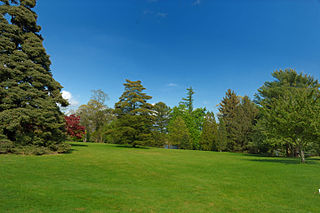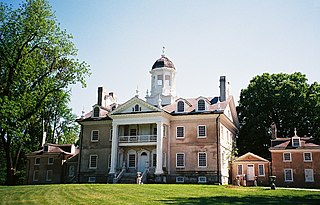
Sir Joseph Paxton was an English gardener, architect, engineer and Member of Parliament, best known for designing the Crystal Palace and for cultivating the Cavendish banana, the most consumed banana in the Western world.
Highgrove House is the family residence of King Charles III and Queen Camilla. It lies southwest of Tetbury in Gloucestershire, England. Built in the late 18th century, Highgrove and its estate were owned by various families until it was purchased in 1980 by the Duchy of Cornwall from Maurice Macmillan. Charles III remodelled the Georgian house with neo-classical additions in 1987. The duchy manages the estate and the nearby Duchy Home Farm.

Bayard Cutting Arboretum State Park is a 691-acre (2.80 km2) state park located in the hamlet of Great River, New York, on Long Island. The park includes an arboretum designed by Frederick Law Olmsted for William Bayard Cutting in 1886, as well as a mansion designed by Charles C. Haight. Today Bayard Cutting Arboretum State Park is one of the last remaining estates on the South Shore of Long Island. It has been listed on the National Register of Historic Places since 1973 as a historic district. Robert Fulton Cutting, known as the “first citizen of New York” and his wife Helen Suydam Cutting, niece to Caroline Astor, would frequent the manor house and estate as both William and Robert were brothers. Together Robert and William brought the sugar beat industry to the United States.

A mansion is a large dwelling house. The word itself derives through Old French from the Latin word mansio "dwelling", an abstract noun derived from the verb manere "to dwell". The English word manse originally defined a property large enough for the parish priest to maintain himself, but a mansion is no longer self-sustaining in this way. Manor comes from the same root—territorial holdings granted to a lord who would "remain" there.

Biltmore Estate is a historic house museum and tourist attraction in Asheville, North Carolina. Biltmore House, the main residence, is a Châteauesque-style mansion built for George Washington Vanderbilt II between 1889 and 1895 and is the largest privately owned house in the United States, at 178,926 sq ft (16,622.8 m2) of floor space. Still owned by George Vanderbilt's descendants, it remains one of the most prominent examples of Gilded Age mansions.

Sonnenberg Gardens and Mansion State Historic Park is a 50-acre (20 ha) state park located at 151 Charlotte Street in Canandaigua, New York, at the north end of Canandaigua Lake, in the Finger Lakes region of Upstate New York. The house and gardens are open to the public every day, May through October.

Hampton National Historic Site, in the Hampton area north of Towson, Baltimore County, Maryland, USA, preserves a remnant of a vast 18th-century estate, including a Georgian manor house, gardens, grounds, and the original stone slave quarters. The estate was owned by the Ridgely family for seven generations, from 1745 to 1948. The Hampton Mansion was the largest private home in America when it was completed in 1790 and today is considered to be one of the finest examples of Georgian architecture in the U.S. Its furnishings, together with the estate's slave quarters and other preserved structures, provide insight into the life of late 18th-century and early 19th-century landowning aristocracy. In 1948, Hampton was the first site selected as a National Historical Site for its architectural significance by the U.S. National Park Service. The grounds were widely admired in the 19th century for their elaborate parterres or formal gardens, which have been restored to resemble their appearance during the 1820s. Several trees are more than 200 years old. In addition to the mansion and grounds, visitors may tour the overseer's house and slave quarters, one of the few plantations having its original slave quarters surviving to the present day.

The Robert Allerton Park is a 1,517-acre (614 ha) park, nature center, and conference center located in the rural Piatt County township of Willow Branch, near Monticello, Illinois, on the upper Sangamon River. The park and manor house, The Farms, are attributed to owner Robert Allerton, industrialist heir, artist, art collector and garden designer. Robert donated the complex to the University of Illinois in 1946.
Robert Hoblyn MP FRS (1710–1756) was an English politician and book collector. He was elected a Fellow of the Royal Society in 1745. He was a Member of Parliament representing the city of Bristol in 1741 and 1747.

Claymont Court, or simply Claymont, is a Georgian-style brick mansion, the grandest of several built near Charles Town, West Virginia for members of the Washington family. The current "Big House" was built in 1840 for Bushrod Corbin Washington, nephew of Supreme Court justice Bushrod Washington and grand-nephew of George Washington, to replace the 1820 main house on his plantation that burned in 1838.
Mamhead is a rural village and civil parish near Dawlish and Kenton in Devon, South West England, in the Teignbridge local authority area. Current community venues include Mamhead Village Hall and The Church of England parish church, dedicated to St Thomas the Apostle,

Shadow Brook Farm Historic District is located in Stockbridge, Massachusetts. It is a historic district that includes six re-purposed farm buildings related to the former 'Shadowbrook' mansion destroyed by fire in 1956. Designed by architect H. Neill Wilson with landscaping by Frederick Law Olmsted, the mansion and farm buildings were built for Anson Phelps Stokes in 1893. Andrew Carnegie acquired Shadowbrook in 1917 and died there in 1919. It served as a Jesuit novitiate from 1922 until 1970. Following the fire, a non-equivalent structure of the same name took its place and currently is home to the Kripalu Center. Today the historic district primarily encompasses Berkshire Country Day School, which acquired its campus from the Stokes family in 1963. The historic district was added to the National Register of Historic Places in 1988.

Belfield, also known as the Charles Willson Peale House, was the home of Charles Willson Peale from 1810 to 1826, and was declared a National Historic Landmark in 1965. The Belfield Estate was a 104-acre (42 ha) area of land in the Logan section of Philadelphia, Pennsylvania, much of which is now a part of La Salle University’s campus.

Raspberry Plain is a historic property and former plantation in Loudoun County, Virginia, near Leesburg. Raspberry Plain became one of the principal Mason family estates of Northern Virginia, and was rebuilt in the early 20th century. It currently operates as an event site, hosting weddings and other special events year round.

Downhill House was a mansion built in the late 18th century for Frederick, 4th Earl of Bristol and Lord Bishop of Derry, at Downhill, County Londonderry. Much of the building was destroyed by fire in 1851 before being rebuilt in the 1870s. It fell into disrepair after the Second World War.

Heanton Satchville was a historic manor in the parish of Petrockstowe, North Devon, England. With origins in the Domesday manor of Hantone, it was first recorded as belonging to the Yeo family in the mid-14th century and was then owned successively by the Rolle, Walpole and Trefusis families. The mansion house was destroyed by fire in 1795. In 1812 Lord Clinton purchased the manor and mansion of nearby Huish, renamed it Heanton Satchville, and made it his seat. The nearly-forgotten house was featured in the 2005 edition of Rosemary Lauder's "Vanished Houses of North Devon". A farmhouse now occupies the former stable block with a large tractor shed where the house once stood. The political power-base of the Rolle family of Heanton Satchville was the pocket borough seat of Callington in Cornwall, acquired in 1601 when Robert Rolle purchased the manor of Callington.
Fir Hill Manor is a manor house near Colan, mid-Cornwall, England, dating from the 1850s. In 1994, it was the subject of a BBC Bristol documentary, which tells the story of former Newquay policeman Derek Fowkes as he searches for absentee landlord, John Paget Figg-Hoblyn. John Paget Figg-Hoblyn claimed to be the rightful heir to the estate after the death of his father, Francis, who died in 1965. The inheritance was not settled for over 40 years.

Summerhill House was a 100-roomed mansion in County Meath, Ireland which was the ancestral seat of the Viscounts Langford and the Barons Langford. Built in 1731, Summerhill House demonstrated the power and wealth the Langford Rowley family had at the time. They owned vast amounts of land in counties Meath, Westmeath, Cork, Londonderry, Antrim, and Dublin as well as in Devon and Cornwall in the England.

Kirroughtree House is the heritage-listed mansion house of the Kirroughtree estate. It occupies a prominent position 1 mile (1.6 km) northeast of the town of Newton Stewart in the Galloway region of southwest Scotland. The main access is from the A712 close to its junction with the A75. Kirroughtree House was the family seat of the Heron family from the 14th or the 15th century until the 1880s. The mansion house is now a luxury hotel. While remnants of an older house have been found in a blocked-off cellar, the current house dates to 1719 with extensions to the northeast added in the 19th and early 20th century. The house has connections with both James Boswell and Robert Burns, each of whom stayed at Kirroughtree House as guests in the later 18th century.

John Quicke (1724–1776) of Newton House in the parish of Newton St Cyres in Devon, was Sheriff of Devon in 1757.
















